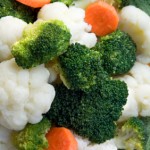You already know that cruciferous vegetables—broccoli, cauliflower, brussel sprouts, kale, cabbage and bok choy—are good for you. Now research is showing that they may be grocery store super foods. Read more
 It is common knowledge that cruciferous vegetables contain phytochemicals, vitamins, minerals and fibre, half of which is cholesterol-lowering soluble fibre. These are all important to your health.
It is common knowledge that cruciferous vegetables contain phytochemicals, vitamins, minerals and fibre, half of which is cholesterol-lowering soluble fibre. These are all important to your health.
But did you know that eating cruciferous vegetables may help lower your risk of cancer? A review of several research studies published in the Journal of the American Dietetic Association suggests a link between cruciferous vegetable intake and protection against cancer.
Studies that tracked the nutrition intake of people over time have found that diets high in cruciferous vegetables are associated with lower rates of certain types of cancer, such as prostate cancer.
Several different components found in cruciferous vegetables have been linked to the lower cancer risk. In addition, the compounds found in these vegetables act in synergy with each other. According to the American Institute for Cancer Research, they have shown the ability to stop the growth of cancer cells for tumors in the breast, uterus, colon, liver, and cervix.
Another way cruciferous vegetables may help to protect against cancer is by reducing oxidative stress caused by free radical damage in the body.
So the next time you are in the produce aisle, give these vegetables a try.
|
Per 1 cup: |
Broccoli |
Cauliflower |
Cabbage |
B. Sprouts |
Bok Choy |
Kale |
|---|---|---|---|---|---|---|
|
(steamed) |
(frozen, cooked) |
(raw) |
(cooked) |
(cooked) |
(cooked) |
|
|
Calories |
44 |
34 |
22 |
60 |
20 |
36 |
|
Fiber |
5g |
5 |
2 |
4 |
3 |
3 |
|
Vitamin A |
33% DV |
1% |
2% |
16% |
62% |
137% |
|
Vitamin B-2 |
16% |
9% |
3% |
11% |
10% |
8% |
|
Vitamin B-6 |
17% |
12% |
7% |
21% |
22% |
14% |
|
Vitamin C |
165% |
75% |
38% |
129% |
59% |
71% |
|
Folic Acid |
23% |
18% |
10% |
23% |
17% |
4% |
|
Magnesium |
12% |
5% |
4% |
10% |
6% |
7% |
|
Potassium |
14% |
7% |
6% |
14% |
18% |
8% |
|
Omega-3s |
200 mg |
140 mg |
60 mg |
260 mg |
100 mg |
100 mg |
Buying and cooking tips
- To avoid the strong sulfur smell, avoid overcooking these vegetables.
- Add raw broccoli and cauliflower to your veggie platters and salads for an added crunch and a big nutrient boost.
- Chop cruciferous veggies and add them to soups, stews and casseroles.
- If your broccoli has yellow in it or is limp and soft, it is likely old. Don’t buy it. Look for firm florets with a dark green or bluish hue on the top. They typically contain more vitamin C and beta carotene than florets with lighter green tops.
Cauliflower Poppers Recipe
Ingredients:
- 1 spray(s) cooking spray
- 1 small head(s) cauliflower
- 1/2 tsp ground cumin
- 1/2 tsp chili powder, or more to taste
- 1/2 tsp table salt
- 1/2 tsp black pepper
Cooking Time: 10 minutes
Servings: 4
Preparation Time: 5 minutes
Directions:
Preheat oven to 400°F. Coat a baking sheet with cooking spray.
Cut cauliflower into bite-sized pieces (about 4 cups). Place cauliflower in a medium bowl and add cumin, chili powder, salt and pepper; toss to coat.
Spread cauliflower on prepared baking sheet and bake about 10 minutes until cauliflower is tender, but not mushy, stirring halfway through.
This is delicious and healthy. Serve it with a side of balsamic vinegar.
